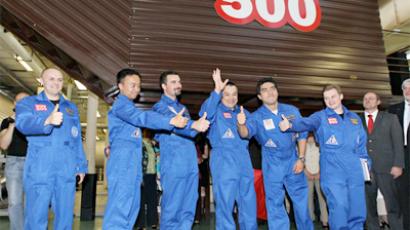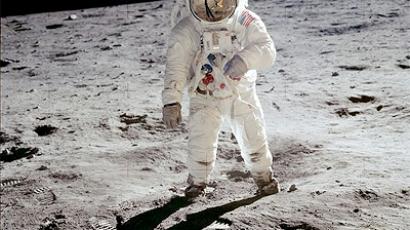Mock Mars mission ‘returns’ to Earth
The crew of the international “mission” to Mars has finally “returned” to Earth in Moscow, bringing one of the world's most grueling scientific experiments to a close.
Six volunteers, including three Russians (Alexey Sitev, Alexandr Smoleevskiy and Sukhrob Kamolov), as well as representatives from Europe (Romain Charles), China (Wang Yue) and South America (Diego Urbina), can now see daylight for the first time in 520 days. That is the exact time they spent isolated in their mock spaceship, simulating a trip to the Red Planet and back.The men have been sealed in the mock spacecraft for 17 months. But they never left the Institute of Biomedical Problems in Moscow, and could have quit the Mars-500 isolation experiment at any time.“It’s not even the first step, we’ve only lifted our foot to take that step,” the head of the Mars-500 project, Boris Morukov, explains. “Before we decide on the equipment that we used in the flight to Mars, we first need to have an understanding of the limits of the human body, its psychological and physiological capacities. Research in human capacities should go before the design of a spacecraft, though our scientists are quite active in designing new vehicles.”A piece of string was set into wax on June the 3rd 2010, but despite many predictions to the contrary, that seal has remained unbroken throughout the experiment. Only now, after all this time, are the men inside being reunited with the outside world.“I was afraid of conflicts that could lead to an early termination of the experiment. We tried to consider all potential risks and to nip all tensions in the bud,” says Yury Bubeyev, a psychologist and physiologist.The scientists behind it wanted to see if the six-man crew would be able to go all that time without severe psychological effects. There have been worries about something called "social narrowing" – the name given to some of the effects of spending a long time in isolation. There have been reports of cosmonauts and astronauts in space suffering from what some have dubbed as “space madness”, when staying in a metal box in space for a long time was cause severe stress.In 2000, when a shorter version of the same experiment was held, two crew members started fighting, while another tried to kiss a female member. Luckily, nothing similar happened this time.From the busy control room, RT’s Tom Barton was able to ask one of them for himself: “How were your relations with your crewmates?”“In the beginning I was hoping that…not hoping, I was maybe waiting for something bad to happen, you know, like a fight or something,” a participant Diego Urbina replied. “Being in such close quarters for such a long time it would be, you know, the most normal thing in the world, but it never happened. We have been a very cohesive team from the beginning.”The experiment was kept as real as possible, with a 20-minute time delay in communications, once the mock ship was on its way. That meant the team was alone. They could talk freely with loved ones, but researchers decided to withhold bad news from the outside world. That was a tricky business.“We had to keep in mind that some information could come in with private correspondence,” Yuri Bubeyev continued. “Some relatives could break the news. In this case, any prolonged silence on our part could lead to tensions and misunderstanding. They could think that we withheld the information deliberately.”The highlight of the crew’s trip was a simulated landing on Mars. With the long isolation and boredom before it, scientists observed with amazement just how real it became for them when they made Martian landfall.“Their pulse rate was 160 beats per minute,” Alexander Suvorov, the Chief Operating Officer of MARS-500 project told RT. “Now compare that with the pulse of the first cosmonaut Yury Gagarin – while in orbit, it was 152 beats per minute.”The outside world too has been intrigued by Mars-500, mostly through betting on how and when the experiment would fail. One bookmaker put eight to one odds on one of the crew members going insane because of it.“We were having a laugh not too long ago about it,” Diego Urbina tells. “We’re happy that somebody won probably a lot of money thanks to betting that nobody went crazy or nobody went out.”Even though the project is only a dry run, it is still a significant achievement for Earth's first Martian pioneers.Knowing that they have been part of something that has been judged as a real step forward for the mankind wanting to reach out and explore the far reaches of space, may partially compensate for the participants of the experiment for being away from their loved ones for such a long time.
















